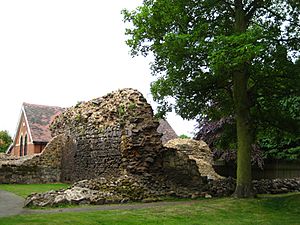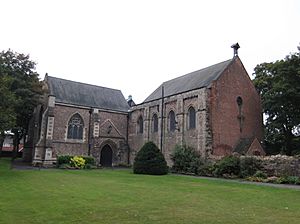Nuneaton Priory facts for kids
Nuneaton Priory was a special religious building in Nuneaton, Warwickshire, England. It was a medieval Benedictine monastery, which means it was a home for nuns who followed the rules of Saint Benedict.
The priory was first started in 1153 by two important people, Robert de Beaumont and Gervase Paganell. It was initially built in a place called Kintbury in Berkshire. This priory was like a "daughter house" to a much larger monastery, Fontevraud Abbey, located in France.
Just a couple of years later, around 1155, the priory moved to a new location. This new place was called Etone, which later became known as Nuneaton. The name "Nuneaton" actually comes from the nuns who lived there!
Over time, Nuneaton Priory became a truly English monastery. This happened around the time when many "alien priories" (monasteries linked to foreign countries) were closed down. Records show that a leader of Nuneaton Priory was still active in 1424, meaning it continued to thrive.
The priory was home to many nuns at different times. In 1234, there were 93 nuns living there, and in 1328, there were 89. However, a terrible disease called the Black Death caused the number of nuns to drop. By 1370, there were 46 nuns, and around 40 in 1459. By 1507, only 23 nuns remained. When the priory finally closed in 1539, there were 27 nuns, and 25 of them were given pensions (regular payments) to live on.
In 1535, King Henry VIII had a survey done to check the wealth of monasteries. This survey, called the Valor Ecclesiasticus, showed that Nuneaton Priory had a net income of about 253 pounds each year. This was a lot of money back then!
The official seal of Nuneaton Priory showed the Virgin Mary. She was shown sitting down, facing forward, and holding the Christ Child on her lap. This image, called the "Seat of Wisdom," was a common symbol for nunneries in medieval England.
The nunnery was taken over in 1539 during King Henry VIII's Dissolution of the Monasteries. This was a time when the King closed down many monasteries across England. After it was seized, Nuneaton Priory slowly fell into ruin.
The Priory Today
The ancient church that was part of the priory, founded in 1155, gave the town its name, 'Nuneaton'.
By the 1800s, not much was left of the original church. Only parts of the old stone pillars from the 12th and 13th centuries remained. Also, some parts of the south wall and the foundations of other sections were still there.
The church has been partly rebuilt and restored over the years. The main part of the church, called the nave, was rebuilt in 1876. This work was done by an architect named Clapton Crabb Rolfe, who followed the Gothic Revival style.
Later, the chancel (the area around the altar) was rebuilt in 1906. The north transept (a part of the church that sticks out like an arm) was rebuilt in 1931 by Harold Brakspear.
Today, the church is known as the Parish Church of St. Mary The Virgin. Locals often call it the Abbey Church. It follows the Anglo-Catholic tradition, which is a style of worship within the Church of England.
Even though this building is very important to Nuneaton's history, it is not very well known. There isn't much promotion or signage to tell people about its significance.



